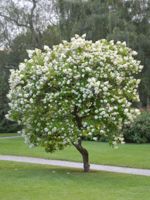Mon-Fri 9am - 5pm Mountain time
Japanese Tree Lilac vs Eastern White Cedar (Arborvitae)
Syringa reticulata
Thuja occidentalis
NOT AVAILABLE THIS SEASON - MIGHT RETURN
Japanese Tree Lilac is an attractive, heavy-flowering lilac with fragrant white blossoms. It can be pruned to a single stem or grown as a multi-stemmed shrub.
Japanese Tree Lilac's dark reddish-brown bark peels as the tree ages, creating visual appeal for any yard, especially in the winter.
This tree is often planted along boulevards and its attractive white flowers signal spring to all who drive by.
Eastern White Cedar is a slender growing conifer often used as a decorative tree or a hedge. This tree is an effective privacy screen even in winter and a great long term solution to urban crowding or a drab yard.
Japanese Tree Lilac Quick Facts
Eastern White Cedar (Arborvitae) Quick Facts
In row spacing: 0.9 m (3 ft)

